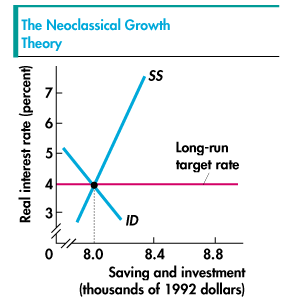Chapter 30

The is one of the three models that economists have developed to help understand the factors that determine a nation's economic growth rate. The neoclassical theory emphasizes the role of capital accumulation. The basic idea is that the greater a nation capital stock, the more output it can produce. Therefore the more rapidly a nation accumulates capital, the more rapidly the capital stock increases and the more rapidly real GDP grows.
We can make the intuition outlined above more specific. Start with the figure on this page. It shows a nation's demand for the stock of capital (KD) and the stock of capital (KS). The real interest rate is determined by the intersection of the demand for capital and the the supply of capital, 4 percent a year in the figure. As discussed in the textbook, the demand for the capital increases and the curve KD shifts rightward when technological change increases the return from capital. And the stock of capital increases and the supply of capital curve KS shifts rightward as people increase their saving. More saving translates into a greater capital stock.
The figure also shows the long-run target interest rate line. Once the actual real interest rate equals the target interest rate, people stop saving. Thus when the interest rate is 4 percent a year, saving is zero and the stock of capital does not change. (We are ignoring depreciation of capital.) With nothing changing the demand for the capital or the supply of capital, the amount of capital remains at $80,000 per person and the nation does not grow.
What can disturb this zero-growth equilibrium? Technological change that boosts the return from owning capital might occur. Technological advance increases the productivity of capital and the demand for capital increases. To see the impact of technological advance on the economy's growth, click on the figure below.
